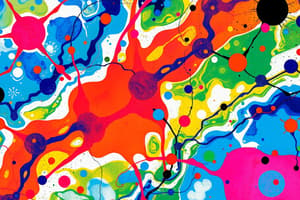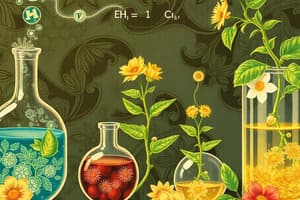Podcast
Questions and Answers
What happens to milk left at room temperature during summers?
What happens to milk left at room temperature during summers?
It undergoes a chemical change.
What is a chemical reaction?
What is a chemical reaction?
A process where the nature and identity of a substance change.
What does magnesium ribbon become when it burns in air?
What does magnesium ribbon become when it burns in air?
Magnesium oxide.
Which of the following observations indicates a chemical reaction has taken place? (Select all that apply)
Which of the following observations indicates a chemical reaction has taken place? (Select all that apply)
What is the word equation for the reaction between magnesium and oxygen?
What is the word equation for the reaction between magnesium and oxygen?
The new substance formed during a chemical reaction is called the reactant.
The new substance formed during a chemical reaction is called the reactant.
The _____ ribbon burns with a dazzling white flame.
The _____ ribbon burns with a dazzling white flame.
Which change is NOT considered evidence of a chemical reaction?
Which change is NOT considered evidence of a chemical reaction?
What does the arrow in a word-equation indicate?
What does the arrow in a word-equation indicate?
What are the substances that undergo change in a chemical reaction called?
What are the substances that undergo change in a chemical reaction called?
When zinc reacts with dilute sulphuric acid, what can be observed aside from gas evolution?
When zinc reacts with dilute sulphuric acid, what can be observed aside from gas evolution?
How would you represent the reaction of magnesium burning in oxygen using a word equation?
How would you represent the reaction of magnesium burning in oxygen using a word equation?
In a chemical reaction, the substances that are produced are called what?
In a chemical reaction, the substances that are produced are called what?
Which of the following is true regarding the representation of chemical reactions?
Which of the following is true regarding the representation of chemical reactions?
What should be observed when lead nitrate is mixed with potassium iodide?
What should be observed when lead nitrate is mixed with potassium iodide?
What is indicated by an unbalanced chemical equation?
What is indicated by an unbalanced chemical equation?
According to the law of conservation of mass, what must remain the same during a chemical reaction?
According to the law of conservation of mass, what must remain the same during a chemical reaction?
In the skeletal equation Mg + O2 → MgO, which side has an unequal number of oxygen atoms?
In the skeletal equation Mg + O2 → MgO, which side has an unequal number of oxygen atoms?
Why is it essential to balance a skeletal chemical equation?
Why is it essential to balance a skeletal chemical equation?
In the reaction Zn + H2SO4 → ZnSO4 + H2, which element has an equal number of atoms on both sides?
In the reaction Zn + H2SO4 → ZnSO4 + H2, which element has an equal number of atoms on both sides?
What is the number of iron atoms in the unbalanced chemical equation Fe + H2O → Fe3O4 + H2?
What is the number of iron atoms in the unbalanced chemical equation Fe + H2O → Fe3O4 + H2?
What process must be applied to the equation Fe + H2O → Fe3O4 + H2 in order to balance it?
What process must be applied to the equation Fe + H2O → Fe3O4 + H2 in order to balance it?
Which of the following represents a balanced chemical equation based on the law of conservation of mass?
Which of the following represents a balanced chemical equation based on the law of conservation of mass?
Flashcards are hidden until you start studying
Study Notes
Chemical Reactions
-
Chemical reactions are processes that change the nature and identity of substances.
-
Examples of chemical reactions: milk spoiling, iron rusting, grape fermentation, cooking food, digestion, respiration.
Observing Chemical Reactions
-
Activity 1.1: Burning magnesium ribbon in air produces a dazzling white flame and forms magnesium oxide (white powder).
- Magnesium reacts with oxygen in the air.
-
Activity 1.2: Mixing lead nitrate solution with potassium iodide solution forms a yellow precipitate.
-
Activity 1.3: Adding dilute hydrochloric acid or sulfuric acid to zinc granules produces bubbles (hydrogen gas) and heat.
Signs of Chemical Reactions
- Changes in state (solid, liquid, gas)
- Changes in color
- Evolution of gas (bubbles)
- Change in temperature (hot or cold)
Chemical Equations
- Chemical reactions can be represented using word equations.
- Word equations use the names of the reactants and products.
- For example: Magnesium + Oxygen → Magnesium Oxide
Components of a Chemical Equation
- Reactants: Substances that undergo chemical change.
- Product: New substance formed during the reaction.
- Arrow: Indicates the direction of the reaction (from reactants to products).
Further Reading
- Chemical reactions are a key part of chemistry.
- This chapter goes on to discuss different types of chemical reactions and their symbolic representation (chemical equations).
Chemical Reactions and Equations
- A chemical reaction is a process that involves the rearrangement of atoms and molecules, leading to the formation of new substances.
- Chemical reactions can be represented using chemical equations, which are shorthand notations that describe the reactants and products involved.
- A word-equation is a simple representation of a chemical reaction using the names of the reactants and products.
- A skeletal chemical equation uses chemical formulas instead of words to represent the reactants and products.
- A balanced chemical equation ensures that the number of atoms of each element is the same on both sides of the equation, adhering to the law of conservation of mass.
- Chemical reactions are observed through various changes:
- Change in state
- Change in color
- Evolution of a gas
- Change in temperature
Balancing Chemical Equations
- Balancing a chemical equation involves adjusting the coefficients in front of each chemical formula to ensure an equal number of atoms of each element on both sides of the equation.
- The law of conservation of mass dictates that the total mass of the reactants must equal the total mass of the products in a chemical reaction.
- To balance a chemical equation:
- Draw boxes around each chemical formula.
- List the number of atoms of each element on both sides of the equation.
- Adjust the coefficients in front of the formulas to balance the number of atoms of each element.
- Always ensure that the formulas of the compounds or elements are not altered during the balancing process.
Studying That Suits You
Use AI to generate personalized quizzes and flashcards to suit your learning preferences.




